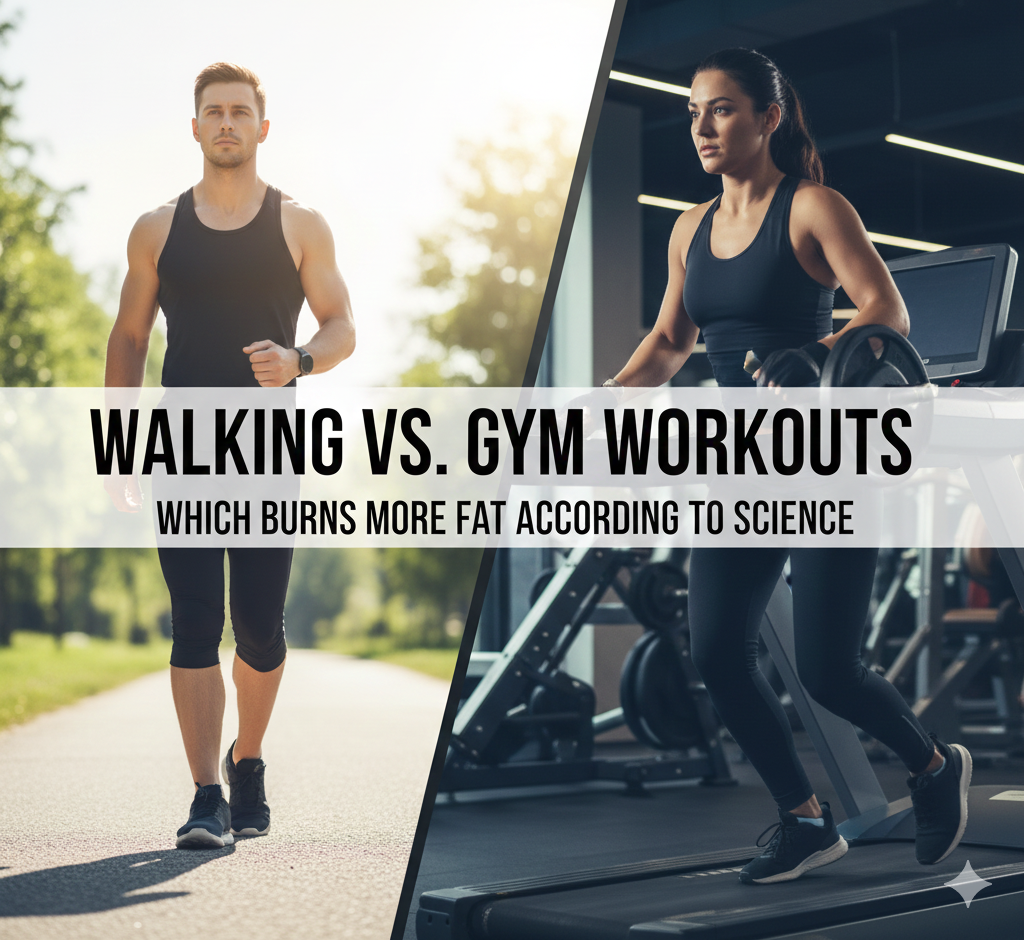In every weight-loss journey, one of the most common questions people ask, especially at Q Slim Fitness, is whether simple walking can burn as much fat as structured gym workouts. For individuals working to build consistency, manage nutrition, and understand their metabolism, choosing the right form of exercise matters. The debate between walking vs gym becomes even more interesting when we look at what scientific research says about fat metabolism, calorie expenditure, and how the body actually responds to different forms of activity.
Before comparing gym and walking, it is essential to understand how fat burns in the body at a biological level. Only then can we evaluate what burns more fat and what really burns fat effectively and sustainably.
How Fat Burns in the Body – The Science Behind Fat Loss
Fat loss is a metabolic process, not a workout. The body burns fat when it is in an energy deficit and when hormones that mobilise fat cells function properly. Understanding how fat burns in the body makes it easier to choose the right activity.
1. Fat Mobilisation
Fat cells store energy in the form of triglycerides. During a calorie deficit, the hormone-sensitive lipase enzyme hydrolyses triglycerides into free fatty acids.
2. Transportation
Once released, these fatty acids enter the bloodstream and travel to tissues and muscles where they can be used as fuel.
3. Oxidation
Inside the mitochondria, fatty acids are oxidised to produce energy. This process is what we commonly refer to as “fat burning.”
Therefore, exercise doesn’t magically “melt” fat; it increases energy demand so that the body uses more fatty acids as fuel. Both walking and gym workouts do this, but in different ways and at various intensities.
Walking for Fat Loss – Slow but Highly Effective
Walking is often underrated because it feels too easy, but scientifically, it is one of the most metabolism-friendly forms of exercise. It keeps the body in the fat oxidation zone, where a higher percentage of energy comes from stored fat rather than carbohydrates.
Why walking works so well for fat loss:
- It is a low-intensity steady-state exercise (LISS), ideal for fat oxidation.
- It does not spike cortisol, which is important because chronic stress can hinder fat loss.
- It is sustainable and can be done daily without burnout.
- It supports recovery, digestion, glycemic control, and overall metabolic health.
Brisk walking keeps heart rate within 50–65% of maximum heart rate, the zone where the body relies heavily on fat for fuel. This makes walking an excellent option for individuals with hormonal imbalances, beginners, and those with joint concerns.
Studies consistently show that even 8,000–10,000 steps a day can significantly improve fat loss, particularly visceral fat around the abdomen.
Gym Workouts for Fat Loss – More Intense, More Calorie-Burning
Gym workouts, whether resistance training, HIIT, or treadmill sessions, create a much higher caloric expenditure. They also build lean muscle, which increases basal metabolic rate (BMR) and enhances long-term fat-burning potential.
Gym training triggers EPOC (Excess Post-Exercise Oxygen Consumption), commonly known as the afterburn effect. This means the body continues to burn calories for hours after the workout.
How gym workouts help with fat loss:
- They build lean muscle, which increases daily energy expenditure.
- Higher intensity increases calorie burn during the workout.
- HIIT-style exercises improve insulin sensitivity and mitochondrial function.
- Strength training reshapes the body and helps prevent weight gain.
While walking burns a higher percentage of fat during the workout, gym sessions often burn more total calories.
What Burns More Fat According to Science?
When comparing walking vs gym for fat loss, the scientific answer depends entirely on context. Walking tends to burn more fat when long-term consistency is the goal, especially for individuals dealing with hormonal concerns such as PCOS, hypothyroidism, or high cortisol, as well as those who are overweight, recovering from injury, or experiencing high stress levels.
It is also more effective for improving insulin sensitivity and lowering inflammation. On the other hand, gym workouts burn more fat when a person is already adapted to regular activity, aiming for visible muscle definition and body recomposition, incorporates strength training, and can sustain progressive overload without experiencing chronic fatigue. Ultimately, what really burns fat is not choosing walking or gym training in isolation, but selecting the right approach based on metabolic health, fitness level, stress response, and personal lifestyle goals
A Scientific Comparison
To determine what burns more fat, let’s compare the two through measurable factors:
1. Calorie Burn
- Walking burns fewer calories per minute but can be sustained longer.
- Gym workouts burn more calories in a shorter period but require recovery.
2. Hormonal Response
- Walking reduces cortisol and improves mood.
- HIIT or intense gym workouts may temporarily increase cortisol, which is not always ideal for individuals under chronic stress.
3. Muscle Growth
- Walking does not build lean muscle.
- Strength training is essential for metabolism and body recomposition.
4. Sustainability
- Walking is easier to maintain daily.
- Gym training requires time, recovery, and access to equipment.
5. Fat Oxidation
- Walking uses fat as the primary fuel source.
- Gym workouts use carbohydrates first but contribute to overall calorie deficit and long-term fat loss.
Which is Better for Fat Loss – The Gym or Walking?
Instead of choosing between walking vs gym, the best results come from combining both. For most people, a blended routine works best:
- Walking to maintain daily energy expenditure and fat oxidation
- Strength training to build lean mass and boost metabolism
- Occasional moderate-intensity cardio to improve stamina and calorie burn
This combination supports both immediate fat use and long-term metabolic improvement.
At Q Slim Fitness, clients often begin with walking, posture correction, and nutrition adjustments before moving into structured resistance training. The approach is personalised depending on metabolic health, hormonal profile, and fitness history.
Why Both Walking and Gym Work Better With Proper Nutrition
No exercise routine, whether walking or gym, can compensate for poor nutrition. What truly drives fat loss is a consistent, moderate calorie deficit supported by nutrient-rich meals. If protein intake is low, muscle recovery slows. If blood sugar fluctuates, cravings increase. If stress and sleep are unmanaged, the body resists fat loss.
This is why fat loss programmes that combine nutrition corrections with structured activity are scientifically superior.
Walking and gym workouts both work beautifully when nutrition supports the metabolic environment required for fat burning.
What Really Burns Fat?
So, what really burns fat is not a single form of exercise but a combination of three key factors:
- A calorie deficit created through balanced nutrition
- Consistent activity, walking for base movement and gym training for muscle
- Healthy hormonal balance, sleep, and recovery
Walking and gym workouts are not competitors. They are partners in creating the ideal metabolic environment for fat loss.
Walking helps you stay consistent. Gym training enables you to get stronger. Nutrition ensures the fat actually comes off. Together, they create sustainable, evidence-based transformation.
Ready to Burn Fat Effectively & Transform Your Body With Expert Guidance?
Understanding whether walking or gym training burns more fat is important, but applying the right method for your metabolism is what creates real results. At Q Slim Fitness Studio, Clinical & Fitness Nutritionist Pallavi Srivastava helps you achieve sustainable fat loss through personalised, science-backed strategies instead of one-size-fits-all workout trends.
Whether your goal is to lose weight, improve PCOS or thyroid health, enhance metabolism, reduce belly fat, or simply feel more energetic, your transformation begins with a customised plan built around your body, hormones, and lifestyle.
Start Your Journey With a Customised Fat-Loss & Fitness Plan
At Q-Slim, every client receives a structured program designed to improve metabolism, optimise fat burning, and build long-term consistency.
Your personalised plan includes:
- Comprehensive Goal Understanding
- In-depth Medical History Analysis (Reports, prescriptions, metabolic and hormonal issues)
- Dietary Recall & Eating Pattern Assessment
- Full Body Assessment (Fat %, muscle %, visceral fat, water %, BMI, BMR)
- Target Weight Calculation
- A Customised Diet Plan Updated Every 10 Days
- Travel-Friendly Diet Options
- Restaurant Guidance for Eating Out
- Exercise Schedule Planner (Walking, strength training, posture correction, progressive workouts)
- Continuous Follow-ups & Support
Whether you prefer walking, gym workouts, or a blend of both, your plan is tailored to maximise fat loss safely and effectively.
Online consultations are available across India and globally through Zoom, Google Meet, or WhatsApp video call, making expert nutrition support accessible from anywhere.
Book Your Consultation Today
To learn more or book an appointment,
Call: +91 9773111531
Email: qslimfitness@gmail.com
Start your journey toward a stronger metabolism, better fat burning, and a healthier, fitter you, guided by an expert who understands your body.

